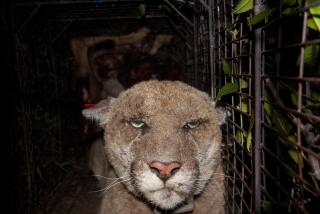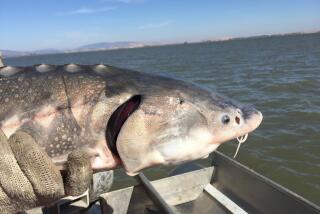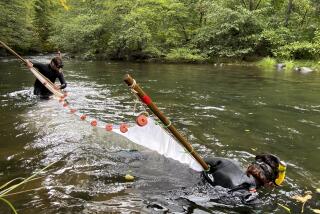Fishermen Fear Croaker Ban Could Sink Them : Business: The state wants to prohibit commercial harvesting of the fish because of chemical contamination off the Palos Verdes Peninsula.
Standing beside his boat on a sun-splashed San Pedro dock, Nick Guglielmo scowled when asked about a planned ban on commercial white croaker fishing off the Palos Verdes Peninsula.
âIt would definitely be an imposition on (our) income,â he said. âI donât feel itâs fair. Itâs just another attempt to push us out of business.â
Guglielmo is one of about a dozen gill net fishermen who catch white croaker off the peninsula. As a group, they are less than pleased by the stateâs plan to outlaw commercial harvesting of white croaker in that area because of chemical contamination.
The fishermen are skeptical of a new study that state health officials cite to justify the ban. They are also angered that recreational and sportfishing will not be affected by the measure--and concerned about losing a valuable part of their catch.
Guglielmo calculates that white croaker from the peninsula account for 15% to 20% of the fish he and his father, Phillip, haul aboard their boat, the St. Aniello, each year. Others say they would be harder hit.
âIâm solely a (white croaker) fisherman, and I barely make a living,â said Bob Aguilar, also of San Pedro. âIf they take this away from me, Iâll lose everything.â
Last Monday, Dr. Kenneth Kizer, director of Californiaâs Department of Health Services, recommended that commercial fishing for white croaker near the peninsula be restricted or prohibited altogether because of chemical contamination.
In response, the state Department of Fish and Game is preparing to ban commercial harvesting of the fish--known locally as kingfish or tomcod--within the state waters stretching from Point Fermin to Point Vicente.
Offenders will face a maximum penalty of six months in jail and a $1,000 fine, according to DeWayne Johnston, chief of the Fish and Game Departmentâs wildlife protection division.
Kizerâs recommendation came after his agency determined in a study that white croaker in peninsula waters had elevated levels of the pesticide DDT and polychlorinated biphenyls, or PCBs.
Thousands of tons of the cancer-causing chemicals were discharged through the Los Angeles County Sanitation Districtsâ sewage outfalls off White Point in the 1950s, â60s and early â70s, contaminating the ocean bottom where white croaker feed.
But the fishermen remain skeptical.
âThe fish we catch in that area look real nice,â Nick Guglielmo said last week. âIâve never felt theyâre contaminated. Thatâs my opinion.â
Such doubts are fueled by the difficulties of establishing a link between white croaker contamination and illness in humans.
In its analysis of 20 white croaker extracted from peninsula waters in 1986 and 1987, the health services study found mean levels of up to 2.98 parts per million of DDT and up to 0.6 p.p.m. of PCBs. These concentrations, the study said, would cause up to one additional cancer per 1,000 people, assuming the fish were eaten once a week over a lifetime.
For Andrew Kuglis, a longtime San Pedro fisherman who is now retired, the complex-sounding statistics are no match for personal experience.
âIâm pretty near 80 years old and been eating that fish all my life,â said Kuglis, whose son, Greg, fishes for white croaker from San Pedro. âIt hasnât poisoned me yet.â
Health officials say the ban is appropriate. Since 1985, they point out, the state has warned non-commercial fishermen to avoid eating white croaker caught off the Palos Verdes Peninsula. Retail customers buying white croaker have remained unprotected, they say.
But many fishermen are unconvinced, complaining that it is unfair to penalize them while allowing non-commercial fishing in the area to continue.
âIf youâre going to close it for commercial (fishing), then close it for everybody,â said Phillip Guglielmo. âEvery day, theyâre chipping away at the places we can fish.â
At the root of all such complaints is the fear of economic losses that the ban would bring.
According to Tony West, vice president of the California Gillnettersâ Assn., little more than a dozen fishermen catch white croaker off the Palos Verdes Peninsula--almost all of them from San Pedro.
As gill net operations go, he says, white croaker fishing is small-scale and within a mile or two of shore, conducted mostly by older fishermen preparing to retire, or young ones who cannot yet afford the gear for fishing farther offshore.
West acknowledges that for many such fishermen, white croaker are only one component of their annual catch. Others include halibut, barracuda, sea bass and bonito.
More to Read
Sign up for Essential California
The most important California stories and recommendations in your inbox every morning.
You may occasionally receive promotional content from the Los Angeles Times.










